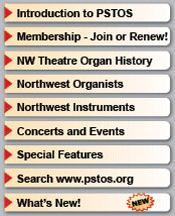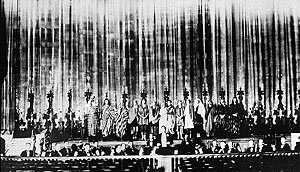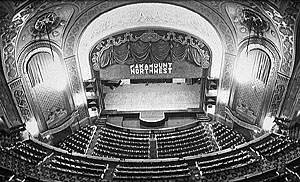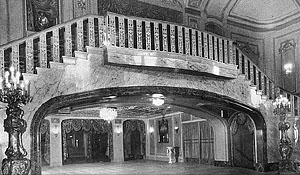


Paramount Theatre - Wurlitzer Publix 1 (initially 4/20, currently 4/21)
The following is an edited version of material from the Seattle Paramount Theatre web site:
Seattle, Washington
Back to the Paramount Theatre main page
http://www.theparamount.com
© 1996-2001
Seattle Theatre Group.
![]()
From 1900 to 1930, Seattle was home to one of the largest vaudeville circuits in the
country. Typical performance bills included live entertainment followed by a silent
film with organ accompaniment. Men and women of all ages and social backgrounds
came to the theaters day and night to soak in Hollywood's glorious rays, watch Russian
acrobats build human pyramids on the stage, and hear the orchestra swing.

Opening Night for the the Paramount (formerly
Seattle) Theatre in 1928.

One of the most popular attractions of any program was always the organ. Beginning with
John Clemmer's Dream Theatre in 1905, every theater in the city resounded with the
vibrating chords of theater organs. Over time Seattle became known as the "cradle of the
theater organ."

One of the most impressive theater organs ever built was the Wurlitzer Publix, but only three
remain in their original environments, the rest having been sold to private owners,
placed in pizza restaurants, or simply dismantled. One of those three remaining Publix
organs can be found at the Paramount Theatre.
Installed at a cost of over $100,000, the Paramount's mighty Wurlitzer includes hundreds
of pipes, chimes, whistles, and horns. An entire grand piano and drum-percussion set is
built into the side panels of the auditorium.
Gaylord B. Carter, chief organist at the Paramount in the '30s, became one of the most
famous theatre organists in America.

In May 1994, the Paramount's "Tribute to 1928" opened when the famous jazz pianist
and organist Dick Hyman played a medley of songs by Fats Waller, himself an organist at
the Harlem Theatre in the 1920s.
Lovingly cared for by the Puget Sound Theatre Organ Society, the
Paramount's own Endangered Species is certainly safe and sound. A new room has been built
to safely store the organ console next to the orchestra pit for those occasions when its
pipes may blow and bells may ring.
About this site © PSTOS, 1998-2004